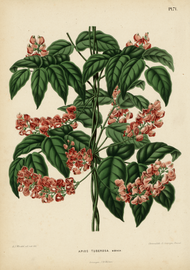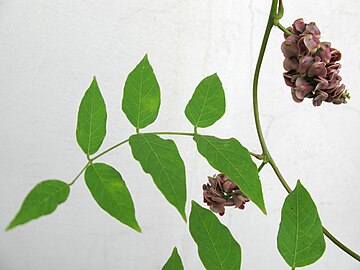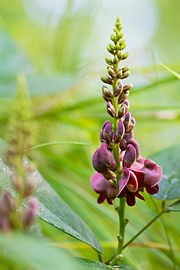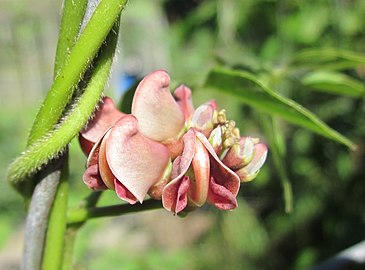Apios americana
| American groundnut | |
|---|---|

| |
| Flowers | |
| Scientific classification | |
| Kingdom: | Plantae |
| Clade: | Tracheophytes |
| Clade: | Angiosperms |
| Clade: | Eudicots |
| Clade: | Rosids |
| Order: | Fabales |
| Family: | Fabaceae |
| Subfamily: | Faboideae |
| Genus: | Apios |
| Species: | A. americana
|
| Binomial name | |
| Apios americana Medik. | |
| Synonyms[2] | |
|
List
| |
Apios americana, sometimes called the American groundnut, potato bean, hopniss, Indian potato, hodoimo, America-hodoimo, cinnamon vine, or groundnut (not to be confused with other plants in the subfamily Faboideae sometimes known by that name) is a perennial vine that bears edible beans and large edible tubers.[3]
Description
The vine of American groundnut can grow to 1–6 metres (3+1⁄2–19+1⁄2 feet) long. It has pinnate
Genetics
The species is normally 2n=2x=22,
Distribution and habitat
The plant's natural range is from southern Canada (including Ontario, Quebec, and New Brunswick) down through Florida and west as far as the border of Colorado.[3]
Ecology
The species is a larval host for the Epargyreus clarus.[8]
Nitrogen fixation
American groundnut fixes its own nitrogen, which could be a great advantage in comparison to other roots crops, such as potatoes, true yams, and sweet potatoes. These do not fix their own nitrogen and require large applications of nitrogen fertilizer or cover cropping with nitrogen fixing plants. [9] American groundnut can be nodulated by bacterial strains that are normally found in symbiosis with soybeans or cowpeas.[9]
Research has been done on the potential of the soybean strain Bradyrhizobium japonicum to nodulate American groundnut.[9] It was found that plants nodulated with B. japonicum yielded ~30% better than unnodulated plants if no nitrogen fertilizer was used.[9] It was also determined that nodulated plants partitioned more carbon into non-edible shoots when they were given nitrogen fertilizer, whereas unnodulated plants responded to nitrogen fertilizer with greater tuber yields than nodulated plants.[9] This data suggests that nitrogen fertilization may be required to maximize tuber size and yields in A. americana.[9]
Cultivation
Domestication
American groundnut is generally considered to be an undomesticated crop. In her 1939 description of the Native American use of American groundnut, Gretchen Beardsley states that several historical sources describe the "cultivation" of American groundnut by indigenous peoples. She dismisses the ambiguous term "cultivation" as perhaps referring to transplantation of tubers near a settlement. She quotes the historical author Waugh on this subject of cultivation: "sometimes planted in suitable locations, though they are not, strictly speaking, cultivated."[10] Subsequent authors on the American groundnut have followed Beardsley's interpretation of "cultivation" when referring to the early use by Indigenous peoples of American groundnut. However, recent evidence suggests that North American indigenous peoples likely intervened significantly as cultivators of the native plants of the region, in a manner similar to contemporary Western permaculture practices.[11] So, from a permacultural perspective, Native Americans may well have "cultivated" the groundnut. Evidence suggests it was cultivated by the Shawnee tribe with corn and squash in a method known as three sisters gardening. Apios would provide nitrogen for the heavy-feeding squash.
In 1985, Dr. William J. Blackmon, Dr. Berthal D. Reynolds, and their colleagues at
From 1985 to 1994, an Apios breeding program took place that resulted in the collection of over 200 wild accessions. These accessions underwent
The largest germplasm collection of A. americana cultivars today is found at Iowa State University under the direction of Dr. Steven Cannon.[15] It is maintained there for scholarly and academic use. Research continues at Iowa State on the domestication of American groundnut.[15][16]
Despite these efforts at domestication, the American groundnut remains largely uncultivated and underused in North America and Europe.[12] There are challenges to breeding and domesticating this plant, as well.[17] There seems to be a partial self-incompatibility with Apios breeding and manual pollinations, resulting in rare seed-sets.[17] Disadvantages in Apios as a crop are its vining habit.[18] The crop has small tuber size for most genotypes.[18] These sizes are typically smaller than 50 g (1.8 oz); however, some do average around 100 g (3.5 oz).[18] The tuber plant is difficult to harvest because of the "beads on a string" arrangement on stolons, which extend for over a meter.[18]
In Japan and South Korea
The only place in the world today where American groundnuts are commercially farmed in any significant quantities is in
It has become a culinary specialty of the
An important part of the spread and popularization of American groundnut consumption in Japan has been the efforts of Dr. Kiyochika Hoshikawa to promote the cultivation of this crop in Japan, and the flurry of scientific articles on the health benefits of eating American groundnut tubers.[20] Japanese websites that sell American groundnut continue to emphasize its health benefits in their marketing efforts.[25][27] There are reports of American groundnut cultivation in South Korea as well, where it is grown for its nutritional benefits.[15]
Toxicity
Studies in rats suggest that raw tubers should not be consumed. They contain harmful
Uses
The tubers and seeds can both be cooked and eaten.[29]
By Indigenous peoples of the Americas
The tubers have traditionally been a
By Europeans
The Europeans learned to use the American groundnut from the Indigenous peoples of the Americas. As a result, the American groundnut became interwoven with the history of the American colonies and
Philosopher Henry David Thoreau commented on the nutty flavor and dry texture in October 1852.[30]
It is believed that American groundnut may have been shipped to Europe as early as 1597. It was listed in 1885 as a European garden crop.[3] In 1845 it was evaluated as a possible alternative potato crop in Ireland during the Great Famine.[3] These early introductions to Europe appear to have resulted in little or no assimilation of the new food into the European diet.[3] A primary reason for this lack of assimilation was that the two-year cycle for an acceptable tuber yield did not match the cropping systems that were familiar to Europeans.[3]
Nutrition
The tubers are highly palatable with culinary characteristics of a potato, although the flavor can be somewhat nuttier than a potato and the texture can be finer.[12] These tubers contain roughly three times the protein content of a potato (16.5% by dry weight), and the amino acid balance is good with the exception of cysteine and methionine.[31] A. americana tubers were found to have a protein concentration of 15–30 milligrams per gram (0.24–0.48 ounces per pound),[32] similar to that of other species in the genus, A. carnea and A. fortunei.[32] However, A. americana had larger levels of genistein than the other two species.[32] The fatty acid content of tubers is approximately 4.2% to 4.6%, with linoleic fatty acids predominating.[33] The fresh weight of a tuber is 36% of carbohydrate (primarily starch).[19] The tubers are also an excellent source of calcium and iron.[19] Calcium content is tenfold greater than a potato and iron is twofold greater than a potato, although vitamin C was considerably less than a potato.[19] The tuber and the flower also contain monosaccharides and oligosaccharides.[34] The tuber has more of these types of carbohydrates than the soybean, potato, and sweet potato.[34]
In addition, the tubers appear to have numerous health-promoting factors. Hypertensive rats that were fed powdered tubers as 5% of their total diet had a 10% decrease in blood pressure and also a reduction in
Furthermore, a study on A. americana and its flower shows that the flower of the particular plant is not toxic to mice.[37] Consumption of the flower was shown to lower plasma glucose levels in diabetic mice.[37] The flower was shown to have an inhibitory activity on maltose and an anti-hyperglycemic effect in mice, suggesting that not only is it a viable and novel food source for the general population, but also in the prevention of diabetes.
References
- ^ NatureServe (2024). "Apios americana". Arlington, Virginia. Retrieved 12 April 2024.
- ^ "Apios americana Medik". Plants of the World Online. Royal Botanic Gardens, Kew. Retrieved 12 April 2024.
- ^ a b c d e f g h i j k l m Reynolds, Berthal D.; William J. Blackmon; E. Wickremesinhe; MH Wells; RJ Constantin (1990). "Domestication of Apios americana". Advances in New Crops: 436–442.
- .
- ^ JSTOR 2444742.
- ^ doi:10.1139/b76-276.
- ^ S2CID 15127648.
- ^ "Lady Bird Johnson Wildflower Center - The University of Texas at Austin". www.wildflower.org. Retrieved 26 September 2019.
- ^ .
- ^ a b c d e f g h i j k l m n o p q Beardsley, Gretchen (1939). "The Groundnut as used by the native peoples of Eastern North America". Papers of the Michigan Academy of Sciences Arts and Letters. 25: 507–525.
- ISBN 9781931498791.
- ^ a b c d e Dean, Tamara (2007). "Stalking the Wild Groundnut". Orion Magazine. Retrieved 11 January 2014.
- ^ S2CID 88226324.
- ^ S2CID 52211922.
- ^ a b c Belamkar, Vikas; VG Bhattacharya; SR Kalberer; et al. (January 2014). "Identification of Superior Germplasm and Development of Genetic Resources for Apios americana: A potential New Legume Crop". Plant & Animal Genome XXII Meeting. Retrieved 10 January 2014 – via pag.confex.com.
- ^ Cannon, Steven B.; Vikas Belamkar (October 2012). "Using high-throughput sequencing data to speed the domestication of Apios americana - a potential new legume crop" (PDF). VI International Conference on Legume Genetics and Genomics: abstract S–EAD03. Archived from the original (PDF) on 11 January 2014. Retrieved 11 January 2014.
- ^ JSTOR 2444742.
- ^ a b c d Cannon, S.B. (2012). "Reintroducing a novel bean species: Apios americana (Medikus)". Annual Report of the Bean Improvement Cooperative.
- ^ a b c d e f Kinugasa, H; Y Watanabe (1992). "Nutritional composition of the tubers of American groundnut (Apios americana Medikus)". Sonoda Women's College Studies. 26: 209–218.
- ^ .
- ^ .
- ^ a b Hidemasa, Shimada. "Hodoimo America (USA Katamariimo)". mmc.atomi.ac.jp. Niiza, Saitama, Japan: Atomi University. Archived from the original on 29 September 2013. Retrieved 10 January 2014.
- ^ .
- PMID 23402539.
- ^ a b "Groundnut". Archived from the original on 20 March 2007. Retrieved 10 January 2014.
- ^ "Radioactivity Database". radioactivity-db.info (in Japanese). Japan: Ministry of Health Labour and Welfare. Retrieved 10 January 2014.
- ^ Ryuichi, Suzuki. "Suzukien". suzukien.shop28.makeshop.jp. Retrieved 10 January 2014.
- ^
- Carlisi, Jackie; Wollard, Dennis (2005). "History, Culture, and Nutrition of Apios americana". S2CID 70562622.
- Kalberer, Scott; Belamkar, Vikas; Singh, Jugpreet; Cannon, Steven (2020). "Apios americana: natural history and ethnobotany". Legume Perspectives: 29–32.
- These reviews cite this research.
- Johnson, SE (1988). Protein quality evaluation and metabolic effects of Apios americana Medikus tubers (MSc). Baton Rouge, LA: Louisiana State University(LSU).
- Carlisi, Jackie; Wollard, Dennis (2005). "History, Culture, and Nutrition of Apios americana".
- ISBN 0-394-50432-1.
- ^ a b Dean, Tamara (2013). "Stalking the Wild Groundnut". Orion Magazine. Retrieved 26 January 2019.
- .
- ^ .
- .
- ^ .
- .
- ^ PMID 23265491.
- ^ .






